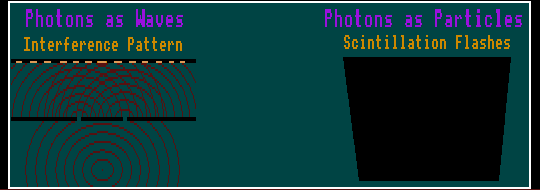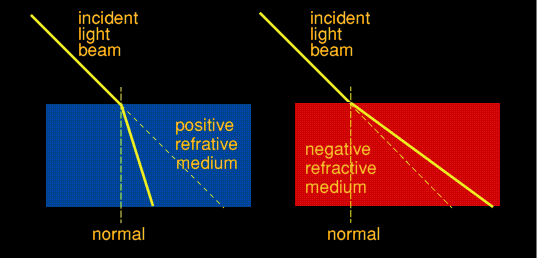

Wave-Particle Duality
Electromagnetic waves exhibit a phenomenon called the wave-particle duality, which means that sometimes they can be made to appear as waves which are demonstrated by interference effects, and at other times can be made to appear like particles called photons when they produce a bright spot of light as they impinge on a phosphorescent screen. In fact neither interpretation is correct and yet both are correct.
Virtual Photons
It is all to do with Heisenbergs' Uncertainty Principle, which says that if you try to measure the exact position of a photon, then its' momentum has huge uncertainty, and vice versa. Or, put another way, if you try to pinpoint the position of the photon in time, its frequency spectrum extends infinitely in both directions, or if you try to measure the frequency of an electromagnetic wave with infinite precision, then it extends infinitely in both spacial directions. The product of the uncertainty in momentum and the uncertainty in position is approximately Plancks constant, h bar. This is related to the borrowing of energy to produce virtual particles. The product of the energy multiplied by the time it is borrowed for must not exceed Plancks constant.
Polarisation
Electromagnetic waves are transverse waves with both magnetic and electric fields travelling perpendicular to each other and to the direction of travel, but in phase; they can be polarised. The polarisation can be either linear where the electric and magnetic fields are at right angles to the direction of travel but otherwise planar; or circular where the plane of polarisation rotates (either clockwise or anti-clockwise) as the beam travels forward. Whichever, the electric and magnetic fields are always at 90 degrees to each other.
Photons with Orbital Angular Momentum
A newly discovered form of laser light can have orbital momentum. By passing laser light through a specially computer-designed diffraction grating, the beam can be made to take on a cork-screw path as it travels forwards. (This is not the same as circular polarisation). The degree of twist (the amount of orbital angular momentum) is quantised, but can be any arbitrarily high integer value, for instance over 200. If three, then the light progresses as a three-lead screw thread along the direction of propagation, if four, then as a four-lead screw thread. The diffraction grating required to produce the twists is specially tailored for each amount of twist.
The Speed of Light
According to Einsteins equations, the speed of light,c, is limited to a finite but what seems an arbitrary value, which by definition is now 'fixed' by convention at 299.792458 ×106 metres per second. Nothing can travel faster than this speed of light. But whether the speed of light in a vacuum can vary over time as the Universe expands, no one knows, but they are constantly measuring it to see if they can find any variation whatsoever. See Constancy of Speed of Light. So far no variation in the speed of light in a vacuum has been detected.
Refractive Index and Slower Light
This is not to say that light cannot travel slower than 299.792458 ×106 m/s. It can, and often does. Light travels slower than c whenever it is traversing a refractive medium, such as air or glass. The speed at which light travels through a refractive medium is inversely proportional to the refractive index of the medium through which it is travelling. Thus glass with a refractive index of 1.5 slows light down to 1/1.5 = 2/3c. The refractive index of everyday transparent liquids and solids rarely if ever exceeds 2. For diamond it is as high as 2.417. Some opaque solids can have a refractive index as high as 10 at electro-magnetic frequencies other than those of the visible spectrum. Germanium is black at optical wavelengths but transparent at infra-red wavelengths where its refractive index is 4.0, and is used as lenses in infra-red imaging cameras.
Negative Refractive Index
It is also possible to fabricate a composite matrix of differing materials with differing shapes such that the refractive index is negative. This has been done using repeating units of coils and wires, but it only operates in the microwave region of the electromagnetic spectrum. It reverses Faradays 'right hand rule' and is therefore called a 'left hand' material. This happens when both the electric permitivity and magnetic pereability of the material are both negative. Whereas materials with a positive index of refraction bend electromagnetic waves towards the normal (a line drawn at right-angles to the surface of the refractive medium); those with negative index of refraction will bend it away from the normal. From a Huygens reconstructed wavefront point of view, it is as though the light in a negatively refracting medium is travelling faster than c. The velocity of an electromagnetic wave has two components, the particle velocity and the phase (or group) velocity. Negative refraction occurs when the two are in opposite directions, akin to the bubbles in a glass of Guinness, where they appear to travel downwards (phase velocity) but the particles (bubbles) actually travel upwards. Materials with negative refractive index open the doorway for filters that reverse the Doppler effect, lenses with sub-wavelength resolution, and almost perfect lenses providing that a material can be constructed to work at optical wavelengths. These so-called 'super-lenses' focus the evanescent waves that objects emit along with the visible light. The evanescent waves are attenuated rapidly and exponentially with distance and do not progress far, but lenses with negative refractive index can focus these to a point less than a sixth of the wavelength of the illuminating light, a feat impossible with ordinary lenses. Extremely thin silver foil is one such material with a negative index of refraction at ultraviolet wavelengths: a planar silver foil only 35 nm thick was used to form a 60nm wide image of ultrathin nanowires; that is six times smaller than the illuminating ultraviolet light.
The ergo-sphere around a rotating Black Hole (outside the Schwartzschild radius) may exhibit negative refraction, and bend light rays passing through it the opposite way to that of gravity. The ergosphere around charged Black Holes may do likewise, as so too a positive value of the cosmological constant. This could affect the apparent positions of some bodies within the Universe.

It is possible to make light travel at a crawl, just a few metres or millimetres per second or to even stop dead.
Sluggish and Stationary Light
One experiment to accomplish this feat involved cooling a 0.2mm long cigar shaped ultra-cold cloud of sodium atoms, at a temperature of just 500 nano Kelvin above absolute zero. By passing a finely tuned beam of laser light through this cloud, the laser light changed the properties of the atoms so drastically that a second dimmer laser beam was slowed to a crawl, travelling just 60km/hour, its whole 1km length now compressed in length to just 0.05mm. The priming laser beam makes the optical medium highly non-linear by forming an entangled system with the ultra-cold atoms. Atoms in the Bose Einstein state slow light the most, but the atoms do not necessarily need to be in the Bose Einstein Condensate state to slow down light. The reduction in speed is not achieved by the atoms acquiring a massive positive refractive index, but rather by creating a very steep refractive index slope, indeed, the refractive index itself is about 1 so the phase velocity of the photons is still c, but the steep refractive index curve drastically reduces the group velocity (the speed of the energy pulse) of the photons.
Also, if the refractive index was far from unity, the beam would not be able to enter the cloud of atoms, but would instead reflect off them. To stop the laser beam entirely, trapping the light inside the cloud, the priming laser is turned off when the second laser pulse is wholly within the cloud. It can then be stored there for almost a second, and only re-emerges when the priming laser is turned back on again. This is, of course, some kind of a trick: the stored light is stored as a kind of holographic diffraction grating imprinted within the cold atoms, which are in quantum superpositional states, the priming laser merely allows the holographic grating to re-construct the original light beam, which, by altering the intensity of the priming laser, can be made brighter or dimmer than the original, but always retaining the phase of the original 'beam'.
|
Cooling Atomic Clouds to 500 nano Kelvin The ultra-cold atoms are obtained by vaporising the sodium atoms and allowing them to escape through a pin-hole. They are travelling at 700m/s, much too fast. They are then slowed down to 50m/s by the radiation pressure from a counter-propagating laser beam in a 1m long magnetic field, a 'Zeeman Slower'. They then encounter three counter-propagating yellow laser beams tuned to just below the sodium atoms resonance, whereupon only those atoms that are travelling fast enough to be in resonance with the beam absorb the photon and in re-emitting it recoil by Doppler effect, travelling slower still. This Doppler Cooling cools them to 50 microKelvin. A third stage of cooling involves plunging then into total darkness and switching on an electromagnet with 4 D-shaped poles, where those atoms that are moving slowly are trapped in the centre, whereas those moving fast escape taking their heat away with them, helped on their way by a radio-frequency field using the same principle as magnetic resonance spectroscopy.. They are now at just 500 nano Kelvin and in a Bose-Einstein Condensate.
|
Light pulses have also been slowed down to just 58m/s in a crystal of alexandrite, a very rare kind of chrysoberyl which is green in daylight and red in artificial light, although the technique is applicable to many solid materials. The process involves changing the refractive index of the crystal to make opaque materials transparent at certain wavelengths either by electromagnetically induced transparency, or by coherent population oscillations within the material induced by a carefully tuned pump laser beam and a weaker probe beam.
![]()
![]()